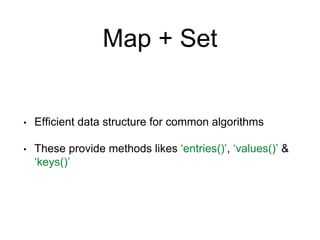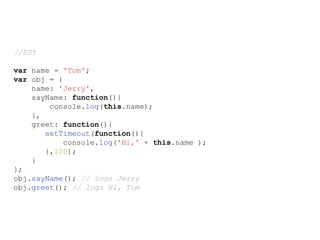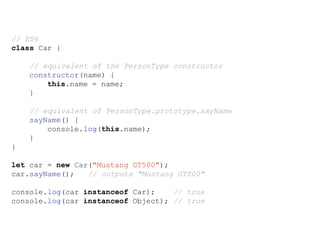ES6: Features + Rails
- 1. ES6Features & Rails Santosh Wadghule @mechanicles
- 3. ES6 + Its Features + Setup on Rails
- 4. ES6? What is it?
- 5. ES6 • ES6 is short name of “ECMAScript Language Specification, Edition 6” • It’s a new version of ECMAScript • ECMAScript is the official name of JavaScript • ES6 provides very nice powerful features • ES6 helps writing more modular and less quirky code in JavaScript.
- 6. ES6 Features
- 7. ES6 Features • Let + Const • Template string • Destructuring Assignment • Default + Rest + Spread • Loops, Generators • Enhanced object literals • Map + Set • Arrows • Modules • Classes
- 8. Let + Const
- 9. Let + Const • Variables before ES6 are function scoped • ‘let’ & ‘const’ are block-scoped binding constructs • ‘let’ is the new variable • ‘const’ is single-assignment.
- 10. Let
- 11. // ES5 "use strict"; function superHeroes() { var superHero1; { superHero1 = "Spider-Man"; var superHero2 = "Batman"; console.log(superHero1); // => "Spider-Man" console.log(superHero2); // => "Batman" } console.log(superHero1); // => "Spider-Man" console.log(superHero2); // => "Batman" } superHeroes();
- 12. function superHeroes() { let superHero1; { superHero1 = "Spider-Man"; let superHero2 = "Batman"; console.log(superHero1); // => "Spider-Man" console.log(superHero2); // => "Batman" } console.log(superHero1); // => "Spider-Man" console.log(superHero2); // => "superHero2 is not defined" } superHeroes();
- 13. Const
- 14. // ES6 function superHeroes(){ const NAME = 'HULK' { const COLOUR = 'green' console.log(NAME); // => 'HULK' console.log(COLOUR); // => 'green' } console.log(NAME); // => 'HULK' console.log(COLOUR); // => COLOUR is not defined } superHeroes();
- 15. // ES6 function superHeroes(){ const NAME = 'HULK' { const COLOUR = 'green' console.log(NAME); console.log(COLOUR); NAME = 'other_name'; } console.log(NAME); console.log(COLOUR); } superHeroes(); // Error: ”NAME" is read-only
- 16. Template Strings
- 17. Template Strings • A new way of string interpolation • It adds syntactic sugar for constructing strings • Easy to handle multiline strings
- 18. // ES6 // basic template string creation. var str = `How you doing?`; var name = 'Joey'; var output = `${name}: ${str}`; console.log(output) // => Joey: How you doing? var first_name = 'john'; var last_name = 'smith'; // Instead of handlling this stuff 'HTTP://example.com/first_name=' + first_name + '&last_name=' + last_name // we can do this very easily. `HTTP://example.com/first_name=${first_name}&last_name=${last_name}` // Multiple Strings. `Oh, I'm sory, Did I break your concentration?` // => Oh, I'm sory, // => Did I break your concentration?
- 20. Enhanced Object Literals • Object literal is the most popular pattern in JavaScript • Based on its syntax, JSON was built • ES6 recognised the popularity of the object literal and extended it in several ways to make it more powerful and even more succinct
- 21. Property Initializer Shorthand // ES5 function createPost(title, content) { return { title: title, content: content }; } //ES6 function createPost(title, content) { return { title, content }; }
- 22. Method Initializer Shorthand // ES5 var car = { name: "Mustang GT500", startEngine: function() { console.log('starting...'); } }; //ES6 var car = { name: "Mustang GT500", startEngine(){ console.log('starting...'); } };
- 23. Computed Property Names // ES5 var car = { "name": "Mustang GT500" }; console.log(car["name"]); // "Mustang GT500" // ES6 var maxSpeed = "max speed"; var prefix = "min "; var car = { "name": "Mustang GT500", [maxSpeed]: "160", [prefix + "speed"]: "0" }; console.log(car["name"]); // "Mustang GT500" console.log(car["max speed"]); // "160" console.log(car["min speed"]); // "0"
- 25. Destructuring Assignment • Destructuring allows you to pattern match against array and objects • It extracts specific values to the individual local variables
- 26. // ES6 // Array matching var [a, , b] = [1,2,3]; console.log(a, b); // => 1 3 // Swapping using array [b, a] = [b, a]; console.log(b, a); // => 3 1 // Object Matching var {emacsUser, atomUser, vimUser } = getEditorUserInfo(); function getEditorUserInfo(){ return { vimUser: 'Tim', emacsUser: 'Sam', atomUser: 'Chris' }; } console.log(emacsUser); // => 'Sam' console.log(vimUser); // => 'Tim' console.log(atomUser); // => 'Chris'
- 27. // ES6 // Object Deep Matching var { user: { fN: firstName, lN: lastName } } = getUserInfo(); function getUserInfo(){ var user = { user: { fN: 'Adam', lN: 'Collins'} } return user; } console.log(firstName); // 'Adam' console.log(lastName); // 'Collins'
- 28. Default + Rest + Spread
- 29. Default + Rest + Spread • Using these features we can handle function’s parameters
- 30. Default
- 31. // ES5 function dailyWorkIncome(workHours, hourlyRate, bonus) { hourlyRate = hourlyRate || 25; bonus = bonus || 0 return (workHours * hourlyRate) + bonus; } dailyWorkIncome(7, 30); // 175 // ES6 function dailyWorkIncome(workHours, hourlyRate = 25, bonus = 0) { return (workHours * hourlyRate) + bonus; } dailyWorkIncome(7); // 175 dailyWorkIncome(7, 30); // 210 dailyWorkIncome(7, 30, 15); // 225
- 32. Rest
- 33. //ES6 function userNames(mainName, ...socialNames) { var allNames = []; allNames.push(mainName); for (let i of socialNames) { allNames.push(i); } return allNames; } userNames('MyName', 'TwitterName', 'GithubName'); // ["MyName","TwitterName","GithubName"]
- 34. Spread
- 35. // ES6 function f(a, b, c) { return a * b * c; } var values = [2,4,6,7]; f(...values); // 48
- 37. Loops //ES5 // Using forEeach on an array. ['John', 'Smith'].forEach(function(item){ console.log(item); }); // Using for-in for object var obj = { name: 'Hulk', color: 'green' } for(var k in obj) { console.log(obj[k]); }
- 38. Loops //ES6 // Using for-of for an array for(let item of ['John', 'Smith']){ console.log(item); } // Using for-of for an object var obj = { name: 'Hulk', color: 'green' } for(let k of Object.keys(obj)) { console.log(obj[k]); }
- 39. Generators • Generator is function which has multiple return points • Allows you to “pause & resume” a function • Interruptible Computations • Shallow Coroutines • Great for simplifying asynchronous code
- 40. function* numbers(){ var n = 1; var a; while(n < 3) { a = yield n++; console.log('a:', a); } }; var gen = numbers(); console.log(gen.next()); console.log(gen.next(2)); console.log(gen.next("three")); // {"value":1,"done":false} // a: 2 // {"value":2,"done":false} // a: three // {"done":true}
- 41. function* numbers(){ var n = 1; var a; while(true) { yield n++; } }; for (var n of numbers()) { if (n > 50) break; console.log(n); } // output: // 1 // 2 // 3 // . // . // . // 50
- 42. Map + Set
- 43. Map + Set • Efficient data structure for common algorithms • These provide methods likes ‘entries()’, ‘values()’ & ‘keys()’
- 44. // Map var m = new Map(); m.set("name", 'John'); var s = new Set(); s.add('Apple').add('Banana'); m.set('fruits', s); for(let entry of m.entries()){ console.log(entry); }; // ["name","John"] // ["fruits",["Apple","Banana"]] for(let entry of m.keys()){ console.log(entry); }; // name // fruits for(let entry of m.values()){ console.log(entry); }; // John // ["Apple","Banana"]
- 45. // Set var s = new Set(); s.add('Apple').add('Banana').add('Apple'); console.log(s.size === 2); // true console.log(s.has('Apple') === true); // true for(let entry of s.entries()){ console.log(entry); }; // ["Apple","Apple"] // ["Banana","Banana"] for(let entry of s.keys()){ console.log(entry); }; // Apple // Banana for(let entry of s.values()){ console.log(entry); }; // Apple // Banana
- 46. Arrows
- 47. Arrows • One of the cool features of ES6 • Arrow function has shorter syntax “=>” syntax compared to regular function • Unlike functions, arrows bind the “this” value as their surrounding code • Arrow functions are always anonymous functions • It throws the error when we use it with “new”
- 48. // ES5 var sum = function(num1, num2) { return num1 + num2; }; var evens = [2,4,6,8]; var odds = evens.map(function(v){ return v + 1; }); // ES6 var sum = (num1, num2) => num1 + num2; var evens = [2,4,6,8]; var odds = evens.map(v => v + 1);
- 49. //ES5 var name = 'Tom'; var obj = { name: 'Jerry', sayName: function(){ console.log(this.name); }, greet: function(){ setTimeout(function(){ console.log('Hi,' + this.name ); },100); } }; obj.sayName(); // logs Jerry obj.greet(); // logs Hi, Tom
- 50. //ES6 var name = 'Tom'; var obj = { name: 'Jerry', sayName: function(){ console.log(this.name); }, greet: function(){ setTimeout( ()=> { console.log('Hi,' + this.name ); },100); } }; obj.sayName(); // logs Jerry obj.greet(); // logs Hi, Jerry
- 51. Modules
- 52. Modules // lib/math.js export const pi = 3.141593; export function double(x){ return x + x; } // app.js import * at math from "lib/math"; console.log(math.pi); // 3.141593 console.log(math.double(10)); // 20 // other_app.js import {pi, double} from "lib/math"; console.log(pi); // 3.141593 console.log(double(10)); // 20
- 53. Classes
- 54. Classes • ES6 classes are syntactical sugar over JavaScript's existing prototype-based inheritance
- 55. // ES5 function Car(name) { this.name = name; } Car.prototype.getName = function() { console.log(this.name); }; let car = new Car("Mustang GT500"); car.getName(); // "Mustang GT500" console.log(car instanceof Car); // true console.log(car instanceof Object); // true
- 56. // ES6 class Car { // equivalent of the PersonType constructor constructor(name) { this.name = name; } // equivalent of PersonType.prototype.sayName sayName() { console.log(this.name); } } let car = new Car("Mustang GT500"); car.sayName(); // outputs "Mustang GT500" console.log(car instanceof Car); // true console.log(car instanceof Object); // true
- 57. ES6 setup on Rails
- 58. ES6 setup on Rails • Work in progress in Sprockets 4.x • Still, we can use sprockets-es6 gem • sprockets-es6 gem uses babel gem internally to transpile your ES6 file to ES5 • Another way using Node.js and Gulp
- 59. ES6 setup on Rails In your Gemfile, add these gems, • gem 'sprockets', ‘>=3.0.0.beta' • gem ‘sprockets-es6’ Run bundle install. Write down your ES6 code in files using .es extension and thats it :)
- 60. Thanks
Editor's Notes
- #3: I work at BigBinary. It’s Ruby on Rails development company. We also do have some good tutorials for JavaScript, ReactJs and Rails. So do check it out.
- #4: Today I’m going to cover.
- #5: Anybody knows?
- #6: In 1995, JavaScript was released(1 stable version), at that time Java was so popular. These JavaScript guys used this Java name to make popular for marketing kind of purpose. But we all love JavaScript. But not for Java :). I’m just Kidding. ES6 had started in 2011, they planed to release first stable version in June 2015.
- #8: Here I have included some of its features which I felt more promising. There are also some new features but I haven’t included here.
- #12: In ES5, variables either function scoped or global scoped.
- #15: In ES5, We define constant using capital letters then we assign to value. But that is not a actual Constant, because can not prevent it from being changed. It’s only convention that we should not change it the program. But ES6 includes new way to declare constants by using ‘const’ instead of using ‘var’.
- #21: What is object literal? It compound value where we can set properties and that property can hold their own values of any type. It is strongest part of JavaScript. Because of this we can implemented module pattern in the JavaScript very easily.
- #22: ES5, duplicated property and duplicated local variable name.
- #23: This is called as concise method syntax.
- #26: One of the best features of ES6. It definitely will improve the productivity of JavaScript developers
- #27: Array matching and Swapping using array, These concepts are taken from CoffeeScript.
- #28: firstName and lastName local variables are specified using object literal syntax
- #30: JavaScript function had not changed much since the language was first introduced
- #33: Rest Parameters. It allows to represent an indefinite number of arguments as an array.
- #40: Generator definitely will be a game changer in Javascript.
- #42: Example of lazy evaluation.
- #48: In JavaScript, we trite a lot function keyword for declaring regular named functions, declaring anonymous functions or callback functions.
- #50: Until arrows functions, every new function defined its own this value. Here this is bound to the global object, not the obj.






















![Computed Property Names
// ES5
var car = {
"name": "Mustang GT500"
};
console.log(car["name"]); // "Mustang GT500"
// ES6
var maxSpeed = "max speed";
var prefix = "min ";
var car = {
"name": "Mustang GT500",
[maxSpeed]: "160",
[prefix + "speed"]: "0"
};
console.log(car["name"]); // "Mustang GT500"
console.log(car["max speed"]); // "160"
console.log(car["min speed"]); // "0"](https://image.slidesharecdn.com/es6ppt-150613161251-lva1-app6892/85/ES6-Features-Rails-23-320.jpg)


![// ES6
// Array matching
var [a, , b] = [1,2,3];
console.log(a, b); // => 1 3
// Swapping using array
[b, a] = [b, a];
console.log(b, a); // => 3 1
// Object Matching
var {emacsUser, atomUser, vimUser } = getEditorUserInfo();
function getEditorUserInfo(){
return { vimUser: 'Tim', emacsUser: 'Sam', atomUser: 'Chris' };
}
console.log(emacsUser); // => 'Sam'
console.log(vimUser); // => 'Tim'
console.log(atomUser); // => 'Chris'](https://image.slidesharecdn.com/es6ppt-150613161251-lva1-app6892/85/ES6-Features-Rails-26-320.jpg)






![//ES6
function userNames(mainName, ...socialNames) {
var allNames = [];
allNames.push(mainName);
for (let i of socialNames) {
allNames.push(i);
}
return allNames;
}
userNames('MyName', 'TwitterName', 'GithubName');
// ["MyName","TwitterName","GithubName"]](https://image.slidesharecdn.com/es6ppt-150613161251-lva1-app6892/85/ES6-Features-Rails-33-320.jpg)

![// ES6
function f(a, b, c) {
return a * b * c;
}
var values = [2,4,6,7];
f(...values); // 48](https://image.slidesharecdn.com/es6ppt-150613161251-lva1-app6892/85/ES6-Features-Rails-35-320.jpg)

![Loops
//ES5
// Using forEeach on an array.
['John', 'Smith'].forEach(function(item){
console.log(item);
});
// Using for-in for object
var obj = {
name: 'Hulk',
color: 'green'
}
for(var k in obj) {
console.log(obj[k]);
}](https://image.slidesharecdn.com/es6ppt-150613161251-lva1-app6892/85/ES6-Features-Rails-37-320.jpg)
![Loops
//ES6
// Using for-of for an array
for(let item of ['John', 'Smith']){
console.log(item);
}
// Using for-of for an object
var obj = {
name: 'Hulk',
color: 'green'
}
for(let k of Object.keys(obj)) {
console.log(obj[k]);
}](https://image.slidesharecdn.com/es6ppt-150613161251-lva1-app6892/85/ES6-Features-Rails-38-320.jpg)





![// Map
var m = new Map();
m.set("name", 'John');
var s = new Set();
s.add('Apple').add('Banana');
m.set('fruits', s);
for(let entry of m.entries()){
console.log(entry);
};
// ["name","John"]
// ["fruits",["Apple","Banana"]]
for(let entry of m.keys()){
console.log(entry);
};
// name
// fruits
for(let entry of m.values()){
console.log(entry);
};
// John
// ["Apple","Banana"]](https://image.slidesharecdn.com/es6ppt-150613161251-lva1-app6892/85/ES6-Features-Rails-44-320.jpg)
![// Set
var s = new Set();
s.add('Apple').add('Banana').add('Apple');
console.log(s.size === 2); // true
console.log(s.has('Apple') === true); // true
for(let entry of s.entries()){
console.log(entry);
};
// ["Apple","Apple"]
// ["Banana","Banana"]
for(let entry of s.keys()){
console.log(entry);
};
// Apple
// Banana
for(let entry of s.values()){
console.log(entry);
};
// Apple
// Banana](https://image.slidesharecdn.com/es6ppt-150613161251-lva1-app6892/85/ES6-Features-Rails-45-320.jpg)


![// ES5
var sum = function(num1, num2) {
return num1 + num2;
};
var evens = [2,4,6,8];
var odds = evens.map(function(v){
return v + 1;
});
// ES6
var sum = (num1, num2) => num1 + num2;
var evens = [2,4,6,8];
var odds = evens.map(v => v + 1);](https://image.slidesharecdn.com/es6ppt-150613161251-lva1-app6892/85/ES6-Features-Rails-48-320.jpg)











